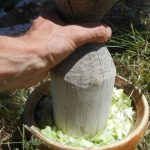I love sauerkraut. I eat it almost every day. When it’s raw, it is full of probiotic bacteria, shown in lab tests to be more beneficial than probiotic supplements. While this post shows you how to make your own, if you do want to buy sauerkraut, make sure it is raw / unpasteurised, the pasteurisation process kills all the beneficial bacteria.
To start with, making sauerkraut might seem like a daunting task, and maybe it does seem that way the first few times you make it, but once you get used to it, it becomes second nature.
I find the recipe to be very flexible, it always works as long as you get the basics right. I use Kilner jars to make my sauerkraut, jars with a rubber seal and clasp (see photo above and photos of the finished sauerkraut in the jar near the end). Kilner jars are not necessary, but they make it slightly less likely to go wrong as they stop any oxygen getting into the jar so you never get mould. And at the same time, they allow any pressure building up in the jar to escape – if you use a jar which seals tightly you will need to open the jar every few days to allow the gasses to escape.
Ingredients
You can make sauerkraut with just cabbage and salt, after all sauerkraut is just the German word for sour cabbage. But we can make it much more interesting that. I choose a selection of seasonal vegetables from the farmers market.
Vegetables I use on a regular basis
Cabbage – green or red, regular, savoy, Chinese, take your pick
Carrot
Pumpkin/Squash
Broccoli
Cauliflower
Red/Yellow/Orange pepper
Courgette (zucchini)
Apple
Radish
Onion (I really like onion in sauerkraut, but don’t put too much as then it doesn’t taste good, half a medium onion per 1 litre works for me)
Other vegetables
Seaweed – I think I tried this once with dried wakame and it worked well, I need to experiment more!
Tomatoes – I once read that tomatoes don’t go in sauerkraut, but I have done it a few times and it worked fine for me. Maybe just a small amount if you use them.
Turnip – works ok, just not on my list of favourite vegetables!
Beans – seem to take longer to ferment than other vegetables, so you end up with the sauerkraut ready apart from the beans. I need to experiment more with this.
Cucumbers – traditionally fermented whole, I’ve never tried putting them in sauerkraut, I imagine they might disintegrate if they are chopped up
What not to put in
Aubergine – I tried once, didn’t really work
Avocado – I’ve never tried, but fatty foods are not usually fermented this way
Salt
I use 1 teaspoon per litre of finished sauerkraut – so if I’m using a 2 litre kilner jar I will use 2 teaspoons of salt. This is never measured very accurately and doesn’t matter too much. The basic principle is the more salt you add, the slower it will ferment. So if it gets really hot in summer and your sauerkraut is fermenting too fast, you can use a little more salt.
Herbs and Spices
You can add all kinds of spices, I particularly like ground coriander seeds. Other traditional spices are caraway seeds or juniper berries.
You can add fresh coriander, fennel, dill, etc, you can flavour it how you like.
Kimchi is a Korean fermented food made with Napa (Chinese) cabbage, which traditionally has a different method, but you can use kimchi spices to make spicy sauerkraut including chilli, ginger, garlic and onion.
Directions
1. Remove the outer leaves of the cabbage and then chop. Or some people prefer to grate it.
2. Add the salt.
3. Smash the cabbage. This is where you need to find suitable tools. I have a wooden bowl and a wooden mallet. You could use the end of a rolling pin. The idea is to release all the juices from the cabbage.
4. Chop the other vegetables. You will need approx 850g of veggies (including cabbage) per litre. I would suggest that you want approx half of this to be cabbage and the other half a mixture of vegetables. Other combinations will work, although if the amount of cabbage is too little there won’t be enough juices to cover everything (and maybe it stops being sauerkraut, there are many other ways to ferment vegetables, see my fermented butternut squash, fermented broccoli and carrot with leek and fermented courgettes recipes).
To get an even ferment, size the pieces based on how quickly they will ferment, generally harder vegetables will take longer than softer ones. So for example pumpkin will need to be much smaller pieces compared to courgette and red pepper. (Note: Don’t smash the vegetables, you only smash the cabbage).
5. Add any herbs and spices
6. Mix everything together well
7. Stuff into the jar. Really push everything down, the idea is that all the vegetables are covered by the liquid (which will have come out of the cabbage as you bashed it). Leave some space at the top of the jar – the liquid will rise up as it ferments, if you don’t leave enough space it will seep out the top of the jar.
8. Place one of the outer cabbage leaves on top, then I use part of the stork to push the vegetables down into the liquid – see photo.
9. Leave at room temperature to ferment. Fermenting time depends on temperature, in the winter (in a relativly cold house) it can take up to 2 months, in summer (in Portugal) it can be ready in 1 week.
If you have any questions or comments, please leave them below. And let me know what your favourite sauerkraut ingredients are.











Thank you so much for this recipe. Definitely helps.
Take Care and Thank you for Continuing Your Fine Work.
Thank goodness a sauerkraut recipe that isn’t loaded with salt – I hate salt!
I’m looking forward to trying your recipe – thank you!
And my mandarin tree is dripping with fruit so I’m going to give your fermented drink a try too. Thanks again. Cheers from S Australia.